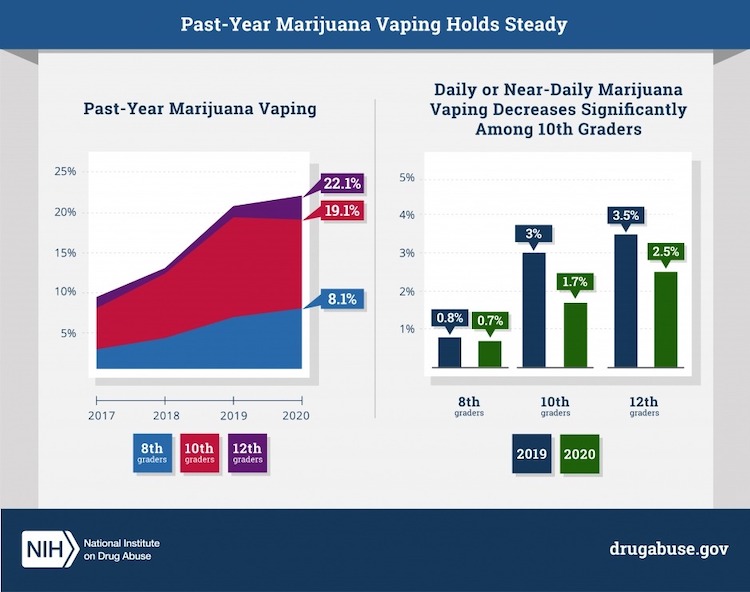Blog
Teen Nicotine Vaping Leveling Off, But Still Very High
Author: Kathleen Nelson-Simley
Posted: Thursday - January 14, 2021
For the first time in its 45-year history, the Monitoring the Future (MTF) study of adolescent substance use was stopped prematurely due to the COVID-19 pandemic. The MTF survey is conducted annually by the University of Michigan’s Institute for Social Research and funded by the National Institute on Drug Abuse (NIDA). It is conducted with students in 8th, 10th and 12th grade across the U.S. who self-report their substance use behaviors over various prevalence periods: daily, past 30 days, past 12 months and lifetime. The survey also documents students’ perceptions of harm, disapproval of use and perceived availability of drugs. The survey results are released the same year the data are collected.
From February 11 through March 14, 2020, the MTF survey investigators collected 11,821 surveys in 112 schools before the surveying stopped with the closure of schools nationwide. While the completed surveys from early 2020 represent about 25% of the sample size of a typical year’s data collection, the results were gathered from a broad geographic and representative sample, so the data were statistically weighted to provide national numbers.
The MTF study is one our most credible national studies offering a yearly snapshot of adolescent substance use. I turn to the MTF study to see what the usage trends are each year. I’ve seen a lot of trends with different substances – trends that primarily show a decrease in use while other trends have raised some serious concerns.
Since the prevention of risky behaviors, specifically vaping among adolescents, was one of the topics many of you indicated as being the most important to you in the survey I conducted in last week’s blog, I thought it would be helpful to offer a summary of the 2020 MTF survey data with you today. I believe it can help set the tone and direction you and I take in our prevention efforts throughout the year.
One of the most important findings of the 2020 MTF survey is that levels of nicotine and marijuana vaping did not increase from 2019 to early 2020, although they remain high.
In the four years since the survey began including questions on nicotine and marijuana vaping, use of these substances among teens have increased to markedly high levels. From 2017 to 2019, the percentage of teens who said they vaped nicotine in the past 12 months roughly doubled for 8th graders from 7.5% to 16.5%, for 10th graders from 15.8% to 30.7% and for 12th graders from 18.8% to 35.3%. In 2020, the rates held steady at a respective 16.6%, 30.7% and 34.5%.

In the report of 2020 MTF results, NIDA Director, Nora D. Volkow, M.D., stated, “The rapid rise of teen nicotine vaping in recent years has been unprecedented and deeply concerning since we know that nicotine is highly addictive and can be delivered at high doses by vaping devices, which may also contain other toxic chemicals that may be harmful when inhaled. It is encouraging to see a leveling off of this trend though the rates still remain very high.”
Past-year vaping of marijuana also remained steady in 2020, with 8.1% of 8th graders, 19.1% of 10th graders and 22.1% of 12th graders reporting past-year use, following a two-fold increase over the past two years.
Survey results also showed that reported use of JUUL vaping devices (also known as e-cigarettes), which contain nicotine and were previously the most popular brand among teens, significantly decreased from 2019 to 2020 among the older two grades. In 10th graders, past 12-month use of JUUL vaping devices decreased from 28.7% in 2019 to 20% in 2020 and in 12th graders, it decreased from 28.4% in 2019 to 22.7% in 2020.
Overall, investigators concluded nicotine vaping for 10th and 12th graders remained steady, despite decreases in use of JUUL, because teens moved to use of other vaping device brands, such as disposable, single use vaping devices.

Yesterday, my local school district – Lincoln Public Schools (LPS) – announced they were joining 250 other school districts around the country in suing JUUL Labs, Inc. for allegedly creating a highly addictive product and targeting young people with fruity and minty flavors and easily concealed pods. Called a mass-action litigation, the LPS lawsuit will be consolidated with lawsuits from 22 states in a California federal court. The lawsuits seek monetary damages to help schools with prevention efforts, such as vaping detectors, supervision, counseling and education efforts. (Read More about the mass-action litigation.)
In the meantime, what do these findings mean for you and me and our work with kids?
We need to personally recognize the harmful effects of vaping. It is not a safer option that cigarette smoking.
We need to use proven, research-based prevention strategies to address vaping and other substances with adolescents.
We need to equip parents with the tools to recognize and address vaping use with their children.
We need to advocate for more research on vaping and its adverse effects and more regulation of the marketing and sale of e-cigarettes to kids.
Investigators are working with schools to deploy the MTF survey early this spring to gather 2021 data that will reflect substance use during the COVID-19 pandemic and related periods of social distancing.
In the meantime, let’s all do the prevention work we need to do for the sake of our kids.




